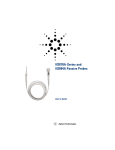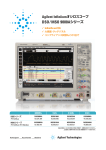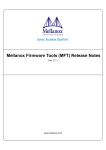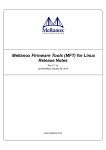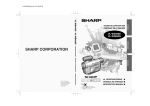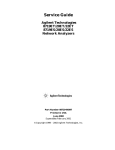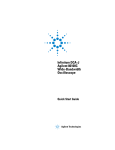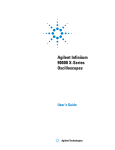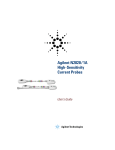Download Agilent Technologies N1022A User`s guide
Transcript
N2795A/N2796A Single-ended Active Probes User’s Guide © Copyright Agilent Technologies 2010 All Rights Reserved. Contents Inspecting the Probe ... 3 Cleaning the Probe ... 3 Handling the Probe ... 3 N2795A/N2796A Single-ended Active Probes ... 4 Accessories Supplied with Probe ... 5 Replacement Accessory Kits ... 6 Characteristics and Specifications ... 7 Performance Data Plots ... 9 Safety Information ... 11 Using the N2795A/N2796A Probes ... 12 Dynamic Range and Offset Voltage Limitations ... 14 Dimensions (in millimeters) ... 8 Accessories ... 15 Configurations 1 and 2: Rigid Probe Tips / Spring Probe Tips and Offset Ground / Ground Blade ... 16 Configuration 3: Copper Pads with Flex Ground ... 19 Configuration 4: Y-Lead Adapter with 0.1” Headers ... 20 Configuration 5: Flex Nose Clips ... 21 Configurations 6 and 7: Ground Leads and Right Angle Ground Leads ... 22 Color Coding Rings ... 23 Calibration Testing Procedures ... 24 To Return the Probe to Agilent Technologies for Service ... 36 2 Inspecting the Probe Inspecting the Probe o Inspect the shipping container for damage. Keep the damaged shipping container or cushioning material until the contents of the shipment have been checked for completeness and the probe has been checked mechanically and electrically. o Check the accessories. • If the contents are incomplete or damaged, notify your Agilent Technologies Sales Office. o Inspect the instrument. • If there is mechanical damage or defect, or if the probe does not operate properly or pass calibration tests, notify your Agilent Technologies Sales Office. • If the shipping container is damaged, or the cushioning materials show signs of stress, notify the carrier as well as your Agilent Technologies Sales Office. Keep the shipping materials for the carrier’s inspection. The Agilent Technologies office will arrange for repair or replacement at Agilent Technologies’ option without waiting for claim settlement. Cleaning the Probe Disconnect the probe and clean it with a soft cloth dampened with a mild soap and water solution. Make sure the probe is completely dry before reconnecting it to an oscilloscope. Handling the Probe ! Handle the probe with care to avoid injury, especially when it is fitted with the sharp spring or rigid tip. Note that the probe cable is a sensitive part of the probe and, therefore, you should be careful not to damage it through excessive bending or pulling. You should also avoid any mechanical shocks to this product in order to guarantee accurate performance and protection. 3 N2795A/N2796A Single-ended Active Probes N2795A/N2796A Single-ended Active Probes The N2795A/96A are a new generation of 1 and 2 GHz single-ended active probes with the AutoProbe interface (compatible with Agilent’s InfiniVision and Infiniium family of oscilloscopes). These probes integrate many of the characteristics needed for today’s general-purpose, high-speed probing - especially in digital system design, component design/characterization, and educational research applications. Its 1MΩ input resistance and extremely low input capacitance (1 pF) provide ultra low loading of the DUT. This, accompanied with superior signal fidelity, makes these probes useful for most of today’s digital logic voltages. And with their wide dynamic range (±8 V) and offset range (±12 V for N2796A, ±8 V for N2795A), these probes can be used in a wide variety of applications. For high signal integrity probing, the N2795A 1 GHz and N2796A 2 GHz active probes are perfect complements to Agilent’s 500MHz – 600MHz and 1 GHz bandwidth scopes, respectively. The N2796A 2 GHz probe can also be used with Agilent’s 2.5 GHz or higher bandwidth Infiniium scope as a low cost alternative to the InfiniiMax probes. The N2795A/96A are equipped with a pleasant white LED headlight to illuminate the circuit under test (picture shown below). The probes are powered directly by the InfiniiVision and Infiniium Autoprobe interface, eliminating the need for an additional power supply. The probes also come with a number of accessories that allow for easy connections to the circuit under test (Accessories Supplied with Probe ... page 5) 4 Accessories Supplied with Probe Accessories Supplied with Probe The following table shows the standard accessories supplied with the N2795A and N2796A probes. Some of these accessories are discussed in greater detail starting on page 15. The Reference Number for each accesory can be matched to the picture below the table. Reference Number 1 2 3 4 5 6 7 8 9 10 11 Accessory Quantity Spring probe tip Rigid probe tip Flex nose clip adapter 2 2 1 (red) 1 (black) 1 1 1 1 2 1 1 4 of each color Copper pads (10x) Y-lead adapter, 10 cm Right angle ground, 5 cm Right angle ground, 10 cm Ground blade Offset ground Flex ground Color coding rings (yellow, green, blue, purple) 3 10 9 1, 2 8 4 7 11 5 6 5 Replacement Accessory Kits Replacement Accessory Kits The following table shows the replacement accessory kits available for the N2795A and N2796A probes. Some of these accessories are discussed in greater detail starting on page 15. Part Number 5061-7388 5061-7389 5061-7390 (red) 5061-7391 (black) 0960-2908 5061-7392 5061-7399 5061-7400 5061-7393 5061-7394 5061-7397 5061-7395 5061-7396 6 Accessory Spring probe tip Rigid probe tip Flex nose clip adapter Copper pads (10x) Y-lead adapter, 10 cm Right angle ground, 5 cm Right angle ground, 10 cm Ground blade Offset ground Flex ground Ground lead, 6 cm Ground lead, 12 cm Quantity 2 2 1 (red) 1 (black) 1 1 2 2 2 2 2 2 2 Characteristics and Specifications Characteristics and Specifications Characteristics and specifications for the N2795A/N2796A Single-ended Active Probes are shown below. The probe / oscilloscope should be warmed up for at least 20 minutes before any testing and the environmental conditions should not exceed the probe’s specified limits. Electrical Characteristics Attenuation ratio (@ DC) Bandwidth (-3 dB)* Probe Risetime (calculated, 10%-90%) Input Dynamic Range Input Resistance* Non-destructive Max Input Voltage Offset Range DC Offset Error (Output Zero) Flatness (both models) Input Capacitance Probe Noise (referred to input) Output Impedance Internal Power N2795A: 10:1 +/- 0.5% N2796A: 10:1 +/- 0.5% N2795A: 1 GHz N2796A: 2 GHz N2795A: 350 ps N2796A: 175 ps N2795A: -8V to +8V (DC or Peak AC) N2796A: -8V to +8V (DC or Peak AC) N2795A: 1 MW +0%, -2.5% N2796A: 1 MW +0%, -2.5% N2795A: -20V to +20V N2796A: -20V to +20V N2795A: +/- 8V N2796A: +/- 12 V N2795A: < +/- 1 mV N2796A: < +/- 1 mV Typical 0.4 dB (100 kHz - 100 MHz) Typical 0.6 dB (100 MHz - 500 MHz) Typical 0.8 dB (500 MHz - 1 GHz) Typical 1.3 dB (1 GHz - 2 GHz)** N2795A: 1 pF N2796A: 1 pF N2795A: < 1 mVrms N2796A: < 1 mVrms N2795A: 50 W N2796A: 50 W Agilent AutoProbe Interface from Scope (InfiniiVision and Infiniium models) *Denotes warranted specification after 20 minute warm-up, all others typical **N2796A only 7 Dimensions (in millimeters) Mechanical Characteristics Approximate Weight (probe only) Cable Length 100 g 1.3 m Environmental Specifications Temperature Operating: 0 °C to +50 °C Non-operating: -40 °C to +70 °C Operating: 4,000 m (13,000 ft) Operating: 95% room humidity @ 40 °C Non-operating: 90% room humidity @ 65 °C 8kV HBM Altitude Humidity ESD Dimensions (in millimeters) 1350 100 7.8 12.1 19 14 8 Performance Data Plots Performance Data Plots Figure 1 Frequency response of N2796A (Vout/Vin) NOTE: This plot is for the spring/rigid probe tip and an offset ground or ground blade. 9 Performance Data Plots Figure 2 Input impedance over frequency (red = measured, blue = model) 10 Safety Information Safety Information Warning ! To avoid personal injury and to prevent fire or damage to this product or products connected to it, review and comply with the following safety precautions. Be aware that if you use this probe assembly in a manner not specified, the protection this product provides may be impaired. Handle Probe Tips / Accessories Carefully Some of the probe tips / accessories are very sharp (the spring tips, for example). You should handle these with care to avoid personal injury. Use Only Grounded Instruments Do not connect the probe’s ground lead to a potential other than earth ground. Always make sure the probe and the oscilloscope are grounded properly. Connect and Disconnect Properly Connect the probe to the oscilloscope and connect the ground lead to earth ground before connecting the probe to the circuit under test. Disconnect the probe input and the probe ground lead from the circuit under test before disconnecting the probe from the oscilloscope. Observe Probe Ratings Do not apply any electrical potential to the probe input which exceeds the maximum rating of the probe. Make sure to comply with the voltage versus frequency derating curve found in this manual. Keep Away From Live Circuits Avoid open circuitry. Do not touch connections or components when power is present. Indoor Use Only Do not operate in wet/damp environments. Keep product surfaces dry and clean. Do Not Operate With Suspected Failures Refer to qualified service personnel. 11 Using the N2795A/N2796A Probes Using the N2795A/N2796A Probes Using the Headlight These probes are equipped with two white LED headlights that can be used to illuminate the area around the probe tip. This headlight has a fixed intensity and is turned on/off by pressing the button on the body of the probe (see picture below). Headlights On/Off Button Connecting Accessories The following picture show where you should connect probe tips and grounding accessories to the body of the probe. Probe tips are connected here Grounding accessories are connected here 12 Using the N2795A/N2796A Probes Oscilloscope Compatibility The N2795A/N2796A probes are compatibile with the following Agilent oscilloscopes (those with the Agilent AutoProbe Interface): • InfiniiVision 5000 Series, software version 6.10 or higher • InfiniiVision 6000 Series (except 100 MHz model), software version 6.10 or higher • InfiniiVision 7000 Series, software version 6.10 or higher • Infiniium 9000 Series, software version 2.50 or higher • Infiniium 90000 Series, software version 2.50 or higher • Infiniium 90000 X-Series (requires N5442A adapter) General Measurement Procedure / Functional Test The following is a generic measurement procedure you can use to ensure your unit is functioning properly. 1 Connect the probe to an oscilloscope channel input and ensure the input 2 3 4 5 impedance of the oscilloscope matches the output impedance of the probe (50W). Equip the probe with a grounding accessory and connect the ground to the ground terminal on the oscilloscope. Connect the probe tip to the Probe Compensation Output on the oscilloscope. Enable autoscale on the oscilloscope. A square wave should now be displayed on the oscilloscope if the probe is functioning properly. 13 Dynamic Range and Offset Voltage Limitations Dynamic Range and Offset Voltage Limitations With the N2795A/96A active probes offering 16 Vpp (+/-8V) of dynamic range and +/-12V (N2796A) or +/-8V (N2795A) of offset range, the probes have a wide measuring range of +/-20V, allowing them to be used for a wide variety of applications. For example, if you wanted to measure small AC noise riding on top of a +10V DC signal, you could use the DC offset feature to position the signal at the center of the screen to keep the probe within its dynamic range. You could then zoom in to see the detail at a higher resolution. Trying to measure a signal out of the dynamic range may result in a clipped or distorted waveform. 14 Dynamic Range and Offset Voltage Limitations Accessories The following sections describe how to use the N2795A/96A probe accessories. They are placed in order from the most recommended configuration to least recommended (based on bandwidth). The configuration card that ships with the probe also shows these recommended configurations. 15 Dynamic Range and Offset Voltage Limitations Configurations 1 and 2: Rigid Probe Tips / Spring Probe Tips and Offset Ground / Ground Blade Bandwidth with N2795A: 1 GHz Bandwidth with N2796A: 2 GHz Replacement Kit Part Numbers (the quantities are the amounts shipped in the replacement kits, not the quantity included with the probe): Rigid Probe Tip: 5061-7389 (qty. 2) Spring Probe Tip: 5061-7388 (qty. 2) Ground Blade: 5061-7393 (qty. 2) Offset Ground: 5061-7394 (qty. 2 These rigid and spring-loaded tips are replaceable. To change the probe tip, pull it straight out of its contact socket along the axis of the probe. Once the probe tip is removed, the new tip can be inserted into the contact socket along the axis of the probe. In order to insert the probe tip completely into the housing, carefully press the probe tip against a hard surface. It is recommended that the spring tips be used with the ground blade as both the tips and ground blade are spring-loaded and will maintain contact with the device under test even when your hand moves slightly. The Rigid/Spring tips and grounds can be mixed with no effect on performance. It is simply a matter of personal preference. Spring loaded probe tips offer a method of probing signals that is less susceptible to vibration or movement than traditional rigid tips. Many users find it easier to use this type of tip. The spring loaded tips work when they are either partially or fully compressed and are protected against over compression damage. Both the spring tip and ground blade are spring-loaded 16 Dynamic Range and Offset Voltage Limitations The recommended grounding accessory for the rigid probe tip is the offset ground as shown. Rigid tip Offset ground Both of these configurations are the highest performing for these probes. For more information on recommended configurations, consult the configuration card that shipped with your probe. Warning You should exercise caution when using these sharp probe tips to avoid personal injury. ! The following images show you how to insert the probe tips and grounds. Spring probe tip 17 Dynamic Range and Offset Voltage Limitations Please note this ridge to tell which end is inserted into the probe Rigid probe tip 18 Dynamic Range and Offset Voltage Limitations Configuration 3: Copper Pads with Flex Ground Bandwidth with N2795A: 900 MHz* Bandwidth with N2796A: 1.8 GHz* *Highly dependent on the number of ground connections between the copper pad and the device under test Replacement Kit Part Numbers (the quantities are the amounts shipped in the replacement kits, not the quantity included with the probe): Copper Pads: 0960-2908 (qty. 10) Flex Ground: 5061-7397 (qty. 2) These self adhesive copper pads can be attached on top of an IC and connected to its ground pins to create a convenient ground plane for the probe to connect to. When used with the flex ground, this method provides an ideal ground connection for probing signals with high frequency content. However, to maximize the performance of this setup, you need to solder as many jumper wires as is practical from the ground pins of the package to the copper pad. The more ground connections, the less inductance in the ground path and the higher the bandwidth capability of the measurement. Insert the Flex Ground and bend it into a shape that makes it easy to contact the copper ground pad on top of the package. 19 Dynamic Range and Offset Voltage Limitations Configuration 4: Y-Lead Adapter with 0.1” Headers Bandwidth with N2795A: 750 MHz Bandwidth with N2796A: 1 GHz Replacement Kit Part Numbers (the quantities are the amounts shipped in the replacement kits, not the quantity included with the probe): Y-Lead Adapter: 5061-7392 (qty. 1) The Y-lead adapter offers a convenient and reliable method to connect both the probe signal and ground to probe points on the board or other probe accessories. For example, this can used to connect to connector headers or to other accessories like the Flex Nose Clip Adapter (see the pictures below). The sockets accept 0.56-0.86 mm round and 0.64 mm square (0.022 - 0.034 inch round and 0.025 inch square) diameter pins. The maximum insertion depth is 7.5 mm (0.295 inch) and the outer insulation of the socket is < 2.54 mm. You can use it for 2.54 mm pitch (0.1 inch) terminals. 20 Dynamic Range and Offset Voltage Limitations Configuration 5: Flex Nose Clips Bandwidth with N2795A: 500 MHz Bandwidth with N2796A: 500 MHz Replacement Kit Part Numbers (the quantities are the amounts shipped in the replacement kits, not the quantity included with the probe): Y-Lead Adapter: 5061-7392 (qty. 1) Flex Nose Clip (red): 5061-7390 (qty. 1) Flex Nose Clip (black): 5061-7391 (qty. 1) You can use flex nose clips to make connections to components or wires with leads that are 1.01 mm (0.04 inches) in diameter or smaller. With today’s miniature IC- and component-packaging techniques, these clips can make probing challenging devices much easier. Most users prefer to attach the clips to the probe via the Y-lead adapter as shown in the picture below. Press the back of the flex nose clip to extend the grasping hook and then release to tighten the hook around the component you are testing. 21 Configurations 6 and 7: Ground Leads and Right Angle Ground Leads Configurations 6 and 7: Ground Leads and Right Angle Ground Leads Replacement Kit Part Numbers (the quantities are the amounts shipped in the replacement kits, not the quantity included with the probe): 6 cm Ground Lead: 5061-7395 (qty. 2) 12 cm Ground Lead: 5061-7396 (qty. 2) 5 cm Right Angle Ground Lead: 5061-7399 (qty. 2) 10 cm Right Angle Ground Lead: 5061-7400 (qty. 2) These ground leads can be used to reach grounding locations that are farther away from the probing location than can be reached by either the ground blade or offset ground. However, the longer leads means they have a larger inductance in the ground return path which corresponds to a lower performance than the ground blade and offset ground. Please note that the straight leads are not included with the probe. They must be ordered as a replacement kit. For more information about the replacement kits, see page 6. 22 Configurations 6 and 7: Ground Leads and Right Angle Ground Leads Color Coding Rings The color coding rings that can be used to keep track of which probe is connected to which channel input on your oscilloscope. Place one ring on the probe cable near the oscilloscope input and place another ring of the same color near the probe head. This ensures that you can pick up a probe and immediately know which channel it is connected to without having to track the cable back to the oscilloscope channel input. 23 Calibration Testing Procedures Calibration Testing Procedures These procedures are used to test the warranted specifications for the N2795A/N2796A single-ended active probes. The recommended calibration test interval for the N2795A/N2796A is once a year or as required. Use the equipment listed in the “Test Equipment Required” section to complete the Calibration Testing Procedures. 24 To Test Input Resistance To Test Input Resistance Required Test Equipment Description Digital Multimeter (DMM) Minimum Requirements resistance ± 1% Part Number Agilent 34401A Test Probe Input Resistance 1 Connect the DMM probes between the probe tip and ground at the tip of the probe. 2 Set up the DMM to measure resistance. The resistance should read 1 MW + 0%, -2.5 %. 3 Record the resistance. _____________ 25 To Test Bandwidth To Test Bandwidth This test ensures that the Probe meets its specified bandwidth. N2795A: 1 GHz N2796A: 2 GHz Equipment/Tool Critical Specification Model Number Vector Network Analyzer (VNA) 13 GHz sweep range full 2 port cal Option 1D5 Agilent 8720ES Calibration Standards No Substitute Agilent 85052D External Power Supply No Substitute Agilent 1143A AutoProbe Interface Adapter No Substitute Agilent N1022A Outside thread 3.5 mm (male) to 3.5 mm (female) adapter No Substitute Agilent 5062-1247 Cable (2) 3.5 mil; SMA; High Quality Agilent 8120-4948 Cable 1.5 mil Probe Power Extension No Substitute Agilent 01143-61602 PV/DS Test Board No Substitute (In E2655B Kit) Agilent E2655-66503 Using the 8720ES VNA successfully Remember these simple guidelines when working with the 8720ES VAN to get accurate stable measurements. 1 Sometimes it may take a few seconds for the waveforms to settle completely. Please allow time for waveforms to settle before continuing. 2 Make sure all connections are tight and secure. If needed, use a vise to hold the cables and test board stable while making measurements. 3 Be careful not to cross thread or force any connectors. This could be a very costly error to correct. 26 To Test Bandwidth Initial Setup 1 Turn on the 8720ES VNA and let warm up for 20 minutes. 2 Press the green "Preset" key on the 8720ES VNA. 3 Use the 8720ES VNA's default power setting of 0 dBm. You can locate this feature by pressing the "Power" key on the front panel. 4 Set the 8720ES VNA's averaging to 4. You can find this selection menu by pressing the "AVG" key. Then select the "Averaging Factor" screen key to adjust the averaging. 5 Press the "Sweep Setup" key on the 8720ES VNA. Then press the "sweep type menu" screen key. Select the "log freq" screen key. 6 Connect the probe under test to the Auto Probe Adapter and power the probe using the 1143A power supply. Install the outside thread adapter to the Auto Probe Adapter. 27 To Test Bandwidth Calibrating a Reference Plane To get a reliable measurement from the 8720ES VNA we must calibrate a reference plane so that the 8720ES VNA knows where the probe under test is located along the transmission line. 1 Press the "Cal" key on the 8720ES VNA. 8120-4948 Reference plane E2655-66503 28 To Test Bandwidth 2 Then Press the "cal menu" screen key. 3 Finally, press the "full 2 port" screen key. 4 Connect one of the high quality SMA cables to port one and to the pincher side of PV/DS test board. 5 The calibration reference plane is at the other end of PV/DS test board. 8120-4948 Reference plane E2655-66503 29 To Test Bandwidth 6 Perform Calibration for the port one side of the Reference plane. • Press the "reflection" screen key • Connect open end of 85052D to the non-pincher side of the PV/DS test board. • Select the "open" screen key under the "Forward" group. • The 8720ES VAN will beep when done. • Connect short end of 85052D to the non-pincher side of the PV/DS test board. • Select "short" screen key under the "Forward" group. • The 8720ES VAN will beep when done. • Connect load end of 85052D to the non-pincher side of the PV/DS test board. • Select the "loads" screen key under the "Forward" group. • Press "broadband" screen key selection. • The 8720ES VAN will beep when done. • Press the "done loads" screen key. • You have just calibrated one side of the reference plane. 30 To Test Bandwidth 7 Connect the other high quality SMA cable to port two of the 8720ES VNA. 8120-4948 Reference plane 8 Get the opposite sex of the 85052D calibration standards for the next step. 9 Perform Calibration for the port two side of the Reference plane. • Press the "reflection" screen key. • Connect open end of 85052D to the available end of the port two SMA cable. • Selec8720ES t the "open" screen key under the "Reverse" group. • The 8720ES VNA will beep when done. • Connect short end of 85052D to the available end of the port two SMA cable. • Select "short" screen key the "Reverse" group. 31 To Test Bandwidth • • • • • • • The 8720ES VNA will beep when done. Connect load end of 85052D to the available end of the port two SMA cable. Select the "loads" screen key the "Reverse" group. Press "broadband" screen key selection. The 8720ES VNA will beep when done. Press the "done loads" screen key. You have just calibrated the other side of the reference plane. 10 Press "standards done" key. 11 Connect port two SMA cable to the non-pincher side of PV/DS test board. 8120-4948 8120-4948 E2655-66503 Reference plane 32 To Test Bandwidth Press the "transmission" screen key. Press the "do both fwd and reverse" screen key. The 8720ES VNA will beep four times when done. Press the "isolation" screen key. Press the "omit isolation" screen key. Press "done 2 port cal" screen key. Set the 8720ES VNA's averaging to off. Save the reference plane cal by pressing the "save recall" key then the "save state" key. 20 You may change name if you wish. 21 Press the "scale reference" key. Then 12 13 14 15 16 17 18 19 • Set for 1 dB per division. • Set reference position for 7 divisions. • Set reference value for 0 dB 22 Press the "measure" key. 23 Press the "s21" screen key. 24 Ensure s21 response on screen is flat out to 1 GHz (N2795A) or 2 GHz (N2796A). 33 To Test Bandwidth Measuring Vin Response 1 Position the probe conveniently to allow the probe tip to be normal to the PV/ DS board. 2 Hold the probe in position, or use a positioner, so that the signal and ground are making contact and are perpendicular to the fixture. Press the "Sweep Setup" key on the 8720ES VNA. Then press the "trigger menu" screen key. Select the "continuous" screen key. 3 You should now have the Vin waveform on screen. 4 Select "display key" then "data->memory" screen key. 5 You have now saved Vin waveform into the 8720ES VNA's memory for future use. 34 To Test Bandwidth Measuring Vout Response 1 Disconnect the port 2 cable from PV/DS test board and attach to probe output 2 3 4 5 6 1 2 3 4 5 on the AutoProbe Adapter. Connect the 85052D cal standard load to PV/DS test board (non-pincher side). Press "scale reference" key on the 8720ES VNA. Set reference value to -20 dB. Hold probe in place as described previously. The display on screen is Vout. Displaying Vout/Vin Response on 8720ES VNA Screen Press the "Display" Key. Then select the "Data/Memory" Screen Key. You may need to adjust the "Reference Value", located under the "Scale Ref" key, slightly to position the waveform at center screen. Press marker key and position the marker to the first point that the signal is -3 dB below center screen. Read marker frequency measurement and record it in the test record located later in this chapter. The bandwidth test passes if the frequency measurement is greater that the probe's bandwidth limit. Example: > 1 GHz (N2795A) or 2 GHz (N2796A). 35 To Return the Probe to Agilent Technologies for Service To Return the Probe to Agilent Technologies for Service If the probe is found to be defective we recommend sending it to an authorized service center for all repair and calibration needs.Follow the following steps before shipping the probe back to Agilent Technologies for service. 1 Contact your nearest Agilent sales office for information on obtaining an RMA number and return address. 2 Write the following information on a tag and attach it to the malfunctioning equipment. • • • • Name and address of owner Product model number Example N2796A Product Serial Number Example MYXXXXXXXX Description of failure or service required Include probing and browsing tips if you feel the probe is not meeting performance specifications or a yearly calibration is requested. 3 Protect the Probe by wrapping in plastic or heavy paper. 4 Pack the Probe in the original carrying case or if not available use bubble wrap or packing peanuts. 5 Place securely in sealed shipping container and mark container as "FRAGILE". If any correspondence is required, refer to the product by serial number and model number. 36 Safety Notices This apparatus has been designed and tested in accordance with IEC Publication 1010, Safety Requirements for Measuring Apparatus, and has been supplied in a safe condition. This is a Safety Class I instrument (provided with terminal for protective earthing). Before applying power, verify that the correct safety precautions are taken (see the following warnings). In addition, note the external markings on the instrument that are described under "Safety Symbols." Warnings • Whenever it is likely that the ground protection is impaired, you must make the instrument inoperative and secure it against any unintended operation. • Service instructions are for trained service personnel. To avoid dangerous electric shock, do not perform any service unless qualified to do so. Do not attempt internal service or adjustment unless another person, capable of rendering first aid and resuscitation, is present. • Do not install substitute parts or perform any unauthorized modification to the instrument. • Capacitors inside the instrument may retain a charge even if the instrument is disconnected from its source of supply. • Do not operate the instrument in the presence of flammable gasses or fumes. Operation of any electrical instrument in such an environment constitutes a definite safety hazard. • Do not use the instrument in a manner not specified by the manufacturer. Agilent Technologies P.O. Box 2197 1900 Garden of the Gods Road Colorado Springs, CO 80901 Safety Symbols ! Instruction manual symbol: the product is marked with this symbol when it is necessary for you to refer to the instruction manual in order to protect against damage to the product or personal injury. Hazardous voltage symbol. Earth terminal symbol: Used to indicate a circuit common connected to grounded chassis. Notices © Agilent Technologies, Inc. 2010 No part of this manual may be reproduced in any form or by any means (including electronic storage and retrieval or translation into a foreign language) without prior agreement and written consent from Agilent Technologies, Inc. as governed by United States and international copyright laws. Manual Part Number N2795-97000, October 2010 Print History N2795-97000, October 2010 Agilent Technologies, Inc. 1900 Garden of the Gods Road Colorado Springs, CO 80907 USA Restricted Rights Legend If software is for use in the performance of a U.S. Government prime contract or subcontract, Software is delivered and licensed as “Commercial computer software” as defined in DFAR 252.227-7014 (June 1995), or as a “commercial item” as defined in FAR 2.101(a) or as “Restricted computer software” as defined in FAR 52.227-19 (June 1987) or any equivalent agency regulation or contract clause. Use, duplication or disclosure of Software is subject to Agilent Technologies’ standard commercial license terms, and non-DOD Departments and Agencies of the U.S. Government will receive no greater than Restricted Rights as defined in FAR 52.227-19(c)(1-2) (June 1987). U.S. Government users will receive no greater than Limited Rights as defined in FAR 52.227-14 (June 1987) or DFAR 252.227-7015 (b)(2) (November 1995), as applicable in any technical data. Document Warranty The material contained in this document is provided “as is,” and is subject to being changed, without notice, in future editions. Further, to the maximum extent permitted by applicable law, Agilent disclaims all warranties, either express or implied, with regard to this manual and any information contained herein, including but not limited to the implied warranties of merchantability and fitness for a particular purpose. Agilent shall not be liable for errors or for incidental or consequential damages in connection with the furnishing, use, or performance of this document or of any information contained herein. Should Agilent and the user have a separate written agreement with warranty terms covering the material in this document that conflict with these terms, the warranty terms in the separate agreement shall control. Technology Licenses The hardware and/or software described in this document are furnished under a license and may be used or copied only in accordance with the terms of such license. WARNING A WARNING notice denotes a hazard. It calls attention to an operating procedure, practice, or the like that, if not correctly performed or adhered to, could result in personal injury or death. Do not proceed beyond a WARNING notice until the indicated conditions are fully understood and met. CAUTION A CAUTION notice denotes a hazard. It calls attention to an operating procedure, practice, or the like that, if not correctly performed or adhered to, could result in damage to the product or loss of important data. Do not proceed beyond a CAUTION notice until the indicated conditions are fully understood and met. Agilent Technologies P.O. Box 2197 1900 Garden of the Gods Road Colorado Springs, CO 80901 Agilent Technologies, October 2010 Manual Part Number: N2795-97000 Only Available Electronically











































